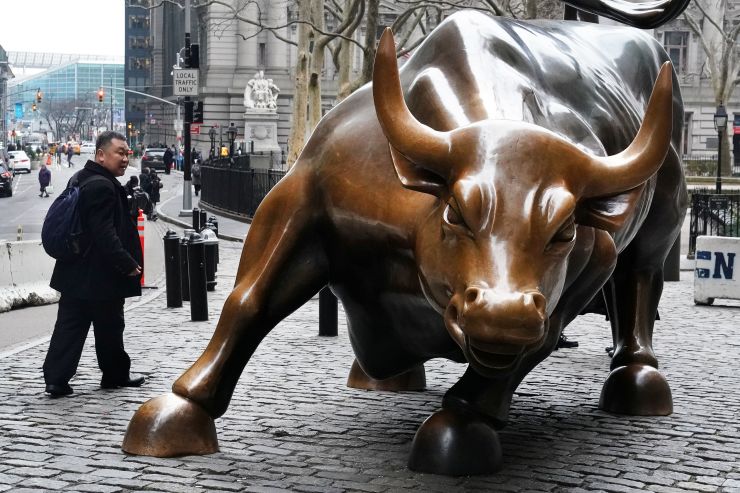
Compared to the rough ride down, stocks have much more quietly and gently recovered more than 13 percent of their losses from the Christmas Eve low.
That’s good news for bullish investors, who expect that the turbulent Christmas lows marked the bottom of the rout that took the S&P 500 down 20 percent on an intraday basis. The S&P 500 Friday closed out a fourth week of gains and was up 13.6 percent from the Christmas Eve close.
“It’s a grind higher, but I think that’s classic. The market takes the stairs up and elevator down. The elevator was a horror show in December. The market is just grinding its way back,” said Art Hogan, chief market strategist at National Securities. “It has happened in a rational fashion, and I think that’s good.”
Strategists say the recovery also could be signaling that the December sell off was an overreaction to fears about a global slowdown, rising rates and trade tensions. The market has since pushed aside its worst fears —that a recession is coming later in the year, and that an overly active Federal Reserve could help bring it on.
“December was out of line with fundamentals,” said Richard Bernstein, CEO Richard Bernstein Advisors. “I think there was tremendous uncertainty. I described it as shooting ourselves in the economic foot … One of the reasons we’ve been so bullish is there’s this underlying fear in the market place that’s normally through time, very bullish. What happens is you had a spike in volatility which begot more fear.”
Bernstein expects the market to be higher than it is now at year end, but not sharply higher.
“I think the market is OK. I don’t think one should be ‘pedal to the metal’ bullish, and I don’t think one should be under your desk in a fetal position,” he said.
Fed concerns pass
Recently, Fed officials have made a concerted effort to assure markets that they are not on a pre-set path to raise interest rates, and they are willing to pause in their hiking. That has reduced concerns about the Fed making a policy error.
There have also been positive news reports of trade progress with China, and that has helped lift stocks and reduce fears that the trade war could be enough of a factor to push the world into recession.
Some strategists believe that stocks could be headed back to the lows, and Morgan Stanley is one firm that believes there will be retest and that an earnings recession, if not real recession is in store.
While there have been positive headlines on trade negotiations between the U.S. and China, the issues are far from settled and the March 1 deadline. News reports this week suggest China may be willing to help improve the trade balance with the U.S., and that the U.S. is considering rolling back tariffs.
But just as quickly as it became a positive catalyst, trade tensions could resume and become a negative, strategists warn. There also remains the unresolved month-long partial government shutdown, which economists say is shaving about a tenth of a percentage point off GDP growth for every week it continues.
To be sure, the worries about the economy persist, particularly since the more than 23 percent growth in corporate earnings in 2018 is expected to give way to a 6 percent or lower growth rate in 2019. Fourth quarter earnings are running at just above 14 growth, but that pace should fall to about 3 percent in the first quarter, according to Refinitiv.
“I think the next big question for markets is does the U.S. fall into recession later this year, or 2020, or does the U.S. skirt recession and have a soft landing,” said Ed Keon, chief investment strategist and fund manager at QMA. “The Fed is signaling they’re moving to the sidelines. It does seem as though there will be stimulus in China, which will reduce the sharp decline there. We’ll see what happens with all the geopolitical risk. There’s a decent chance we will avoid a recession this year. That will be the big issue.”
Worries on the economy
Keon said the market is not signaling a recession although in the heat of December’s downdraft, many strategists said the market was reflecting that fear.
“It’s way too early to say this is the beginning of a recession. the data has been mixed. Industrial production was good,” he said.
However, consumer sentiment plummeted from December’s reading of 98.3 percent in December to 90.7 in January, of 98.3 percent, the lowest reading in more than two years and the biggest drop since September, 2015.
“This report on consumer sentiment is the first concrete evidence that the economy is going to fall and fall hard if Washington does not end the shutdown. It is going to be hard to see real GDP growth of more than 1 to 1-1/2 percent in the first quarter if the consumer goes on a buying strike,” wrote Chris Rupkey, chief financial economist at MUFG.
Keon said he’s positive on the market, but also expects corporate earnings will not grow at all, as earnings estimates continue to decline.
“Once you see that pattern, it usually means you’re going to see estimates continue and this year will be close to zero and has a 50/50 chance of being negative,” he said. “At some point, you’ll look forward to 2020, but with slowing growth and weak earnings that means the upside is reasonably limited … I just don’t think we should expect the really strong start we had to the year means we’re going to have a 20 percent year. That seems very unlikely.”
Hogan, the National Securities strategist, said the weaker earnings growth for 2019 is not really the issue many investors fear it could be because earnings in 2018 received a giant boost from tax law changes.
“The problem with earnings growth is you have to compare it to the year before. Last year was a blockbuster year because you had major tax cuts,” he said. “There were all sorts of things that artificially inflated earnings last year that made the comparison difficult. I’m not much concerned. If we have five to 10 percent earnings growth, considering how much earnings grew last year, I would thank that’s spectacular.”
The S&P 500 has successfully pushed through a level strategists expected to act as a level of resistance, at just above 2,600.
“2,600 had been the lower end of the range for all of 2018. When we dipped below that at the end of the year, significant technical damage was done. We were concerned that would become a ceiling for a period of time but we cut through it on pretty good volume,” Hogan said.
























